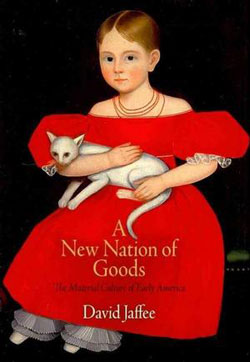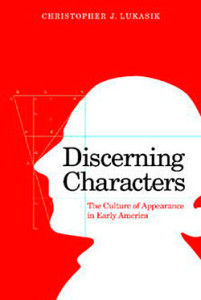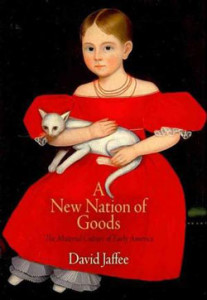But above all, the jockeying between civility and physiognomy unfolded in novels. Lukasik is surely right that novels in the early Republic were very much aboutseeing what was narrated, not least because the narrations were heavy with descriptions of people (and their faces). Indeed, he joins other critics in holding that novels in these years were so oriented toward visuality that reading itself amounted to a kind of spectating (15-16). That said, however, his thesis about the special role of physiognomy leads him to treat the visuality laced into the era’s popular seduction novels as fundamentally an antidote to fraudulent scramblers for higher social position. To Lukasik, these novels, notwithstanding their focus on female victims of villainous men, are ultimately not attacks on patriarchy. Rather, they are defenses of stable prominence. And the defenses they offer turned on physiognomic instruction in how to avoid misperceptions and instead read/see people (especially their faces) accurately enough to detect fake displays of distinction.
For all their elaborate articulations and extensive echoings, however, the dynamics of perception Lukasik ascribes to post-Revolutionary America did not last. Faces remained important. But the second phase of his study, deployed in his last two chapters, takes up a basic change he believes overtook the way appearance was handled, again especially in novels, from the 1820s into the 1850s. He contends that, largely because of steadily mounting cultural democratization, spotting good character shifted from “discerning the visibility of its absence to addressing the invisibility of its presence” (157). Translated, and keying principally to the writings of Cooper and Melville, what this somewhat delphic formulation signals is an evolution from earlier emphases on using faces to spot false claims of distinction to acknowledging that authentic virtue might come in plain wrappers—might involve “the invisible aristocrat” (159) whose fine face is joined to otherwise rough elements of appearance. Yet in the end, Lukasik actually shows Melville taking an additional step.Discerning Characters closes with an extended exegesis ofPierre that has its author questioning the very proposition that engaging faces can have (or ever had) special epistemological value. In Pierre, Lukasik contends, Melville demonstrates the “fallacy” of assuming there existed qualitative advantages to discerning from faces by writing a novel in which problematic consequences arise not just when faces are not studied but even when attempts are made to “read […] character from the face” (187).
It should be apparent that Discerning Characters is a book of both subtlety and ambitious scope. But it is not without limits. Lukasik’s prose can be clunky and repetitive. And his presentation can assume an intricacy that—aside from being hard to summarize in a review—seems at times (at least to this reader) to trip over itself. There are also substantive threads Lukasik leaves dangling. While he mentions in passing the spreading antebellum influence of phrenology, one wishes he had done more to ponder how attending to skulls (instead of faces) affected the culture of appearance. By the same token, Lukasik’s intermittent references to race fall a bit short of explaining precisely how probing faces for underlying good character connected with (or molted into) notions of underlying racial difference.
At another level, Lukasik’s efforts to nest his discussion in the wider visual culture can prompt thoughts of more nestings—can prompt, that is, not criticisms so much as thoughts about how his narrative could have benefited from yet wider framings. So, for instance, the considerable influence of sentiment on how Americans perceived one another between the Revolution and the mid-nineteenth century might have been usefully spliced into his analysis. It might also have been instructive to note that the misappropriations of cultural capital Lukasik maintains were so worrisome to post-Revolutionary elites were not limited, as he implies, to strivers (like Dimple inThe Contrast) trying to crash high society. For there were claims in these years that runaway servants and slaves might “appear […] in dress genteel” just to evade capture.
So too, it would give us a more rounded appreciation of Lukasik’s notion of post-1820 visual patterns if we kept in mind these patterns’ earlier foreshadowings. For it turns out the late 1700s were already familiar with descriptions of “invisible aristocrats” (of eminent figures in plain clothes) and with the belief that faces were hardly the only indicator of admirable character: that “visible signs of … moral purity” in America, as the French visitor Brissot de Warville wrote, “are to be seen everywhere … in the dress of the people, in their houses, and in their churches.” On the other hand, turning matters around, the distinctive changes that didattach to visuality after 1820 might grow clearer if we placed the perceptual struggles found in Melville’s Pierre(and arguably more fully in the same author’s Confidence Man) amidst broader currents buffeting the visual culture of later antebellum decades. For this was when people were evaluated using many visible clues: from faces and skulls to expressions, from clothes and behavior to domestic spaces. But this was equally when in some settings (the Northeast above all), new modes of living and working introduced degrees of skepticism about external appearances well beyond what the early republic had known—and introduced as well efforts to counter such skepticism with newly insistent efforts to dig behind external “looks” to detect “real” truth.
Still, whatever cautions and wider contexts we might propose, Discerning Characters remains an intriguing piece of work, providing innovative and imaginative leverage on how life was experienced and represented (and the relation between experience and representation) from Independence to the mid-nineteenth century. But acknowledging Lukasik’s contribution also leads on to saluting the achievement of David Jaffee’s A New Nation of Goods: the second book under review here and a study that provides its own impressive entry into new historical terrains.
Like Lukasik, Jaffee deals with portraits, including silhouette profiles. For Jaffee, however, the issue is not how (or whether) such images transmitted physiognomic insight about character. The issue is how portraits, in conjunction with an array of certain other artifacts, served to create, in certain locales of early America, a new “material culture”: a “new nation of goods.” Put more concretely, Jaffee’s thesis is that for some seventy years following 1776, up to roughly the 1840s, the rural Northeast (and rural New England especially) was not just a place of farms and scattered cotton and woolen factories—a vista of at best uneven development and at worst stolid backwardness. On the contrary, the northern countryside of this time fairly hummed with getting and making, with swelling acquisition and the production of many different objects.
Remarkable numbers of pictures (especially portraits) were turned out. But so were profusions of artisan-fashioned books, clocks, assorted tables, bureaus, and (especially) chairs. (Jaffee’s interest in what filled houses likely turned him away from an enormous further category of material objects in circulation: clothing.) During the colonial period, only local elites could acquire such items with any frequency. Now, though, they were in many instances sufficiently inexpensive to spread out more widely across northern hinterland society. The result, Jaffee maintains, was a material democratization that “dissolved” the firm markers of pre-Revolutionary gentility while simultaneously fostering the rise of a new, middle class rural “village gentry” and initiating a vibrant (and—in his view—significantly underacknowledged) “Village Enlightenment” (149-50, 83-5, 49).
But this buoyant rustic energy did not last. Like Lukasik (though in a different register), Jaffee posits a decisive change. Taking the emergence of photography as both cause and emblem of transitions in the northern political economy, Jaffee argues that the last two decades of the antebellum period featured a complex medley of developments. On the one hand, more centralized, urban-sited sources of production distributed goods yet more widely (including into the countryside). On the other hand, there arose more rigid social stratifications and a transposition such that artifacts previously vested with “unique stature” now operated mainly as elements of a system. What now took hold, Jaffee writes, was an aesthetic, city-spawned but influential well beyond urban centers, that featured hyper-stuffed interior spaces governed by an unprecedentedly “standardized and commodified design vocabulary” (324-5). The net consequence was that rural makers and consumers of goods, the people responsible for the initial flowering of the Village Enlightenment, were left behind. After 1840 they no longer controlled the material culture they inhabited.
Thus the conceptual arc of Jaffee’s book. But the richness of his presentation deserves equal billing. A New Nation of Goods is a feast. The illustrations—with ten color plates—cover both the paintings and the other items (from books to clocks to chairs) he examines in his text (figs. 2, 3). Moreover, the examination itself is deft and thorough. Jaffee combines the specialized expertise of an antiquarian with the more capacious concerns of an historian. Thus, heeding antiquarian impulses, he recounts precisely how clocks, tables, and chairs were fabricated; he provides biographies of many who did the fabricating; and he traces the provenance of a good number of the resulting artifacts. What’s more, he alerts us to how all this “stuff”—not just paintings but the other items as well—appeared (which is why Jaffee can be placed alongside Lukasik in adding to our understanding of the visual in American history). For objects that were routinely touched, he’s comparably attentive to the tactile, to how they felt in the hand. Yet then, following an historian’s instinct, this micro-perspective is continuously tethered to the overall pattern he evokes: the post-Revolutionary crescendo of production and consumption in the rural North. The result is that the objects he treats not only become (as he must have intended) the real protagonists of his study, but also that these goods are glossed in a manner sufficiently multi-angled to demonstrate how material culture can indeed “enable the social world to happen.” Which in turn, in the specific arena of his investigation, allows him to demonstrate how the goods he examines did in fact “work” to leaven the northern rural milieu generally and register the standing (and expectations) of the post-Revolutionary village gentry particularly (xiv, 45).
Another theme tucked among Jaffee’s pages deserves mention. He repeatedly stresses that the objects he considers are flavored with rural distinctiveness. Numerous centers of hinterland output developed: Walpole, New Hampshire, for books and Gardner and Sterling, Massachusetts, for chairs were examples. Then too, there were shifts in styles. Jaffee remarks a rising taste for vivid color and profuse decoration (for “American Fancy”) that contrasted with more restrained embodiments of the early Village Enlightenment (149, 240). And painters serving the countryside were notably open to deploying new modes of picture-making after exposure to “academic” conventions, or after growing more eager to interpret rather than merely copy their subjects (to become more self-consciously “artists”), or (among women) after building on training in female academies. Still, Jaffee’s point seems to be that notwithstanding diverse locales of production, and despite compositional evolutions and variations, the objects of the rural northeast displayed identifiable rural inflections. In different ways and degrees, they announced their origins. Hence hinterland portraitists proffered flat and plain depictions—the marks of so-called “primitive” imagery— not just because they lacked sophistication but because, whether or not they knew about alternate techniques, they and their customers preferred such likenesses.
So there is, manifestly, much to praise and mull over in A New Nation of Goods. But there are also several topics and issues the book could have brought more fully into play. For one thing, given his focus on household furnishings, it’s curious Jaffee does not give more sustained attention to what domesticity meant in the hinterland Northeast during the years he’s principally investigating. Similarly, it would have been helpful if he had given greater weight to his own documentation of frequent passages between city and countryside. His references to painters and craftsmen moving back and forth between rural and urban locales actually provide material for rethinking how these two spheres functioned together in the early nineteenth century North. Far from contradicting the signature rustic-ness of the goods he’s illuminating, it suggests that a key aspect of this quality was precisely that it existedamid significant contact with cities.
Likewise, it would have strengthened his analysis if he dealt more systematically with the balance between the democratization and economic differentiation he ascribes to the New England countryside before 1840. He evidently wants to find both processes at work. His association of the rising village gentry with the middle class (thus casting this constituency as leading yet not elite) reflects his effort to have it both ways. But there’s probably more to say on this front. While it’s clear enough that widened distributions of goods signaled a material democratization of the northern countryside, the differentiations were also real. The rising village gentry was in some cases as much upper as middling, and in that sense led on quite directly to the heightened stratificationA New Nation of Goods assigns to post-1840 years.
Indeed, the rural production patterns Jaffee describes in such marvelous detail suggest further differentiations implying yet further bridges across the divide between the pre- and post-1840 North. What he records for the earlier period, after all, are manufacturing practices that grew more full-time, distancing those engaged in these activities ever further from farming. And what he’s also describing are practices that not infrequently embraced divisions of labor, or large workshops (sometimes equipped with water- and even steam-powered technologies), or elaborate marketing strategies, or all this together, and all aimed at generating and selling expanding volumes of uniform clocks and chairs. So that the manufacturing he depicts followed a trajectory directed away from both the hinterland’s agricultural core and from artisanal handicrafts. It embraced, or passed quickly into, forms of mass marketing and a full-fledged industrialization not that different from what transpired in contemporary rural textile mills. As such it was manufacturing that demonstrably comprised rural precedents for what Jaffee sees happening after 1840. He preserves the label “middle-class” for the material culture of this later era (324), again presumably to underscore its ongoing democratizing diffusion of goods. But if he had looked back across his own account, he might have concluded that at least part of what drove the aesthetic he sees crystallizing in the 1840s and 1850s—the driving force of centralized production and extensive retailing of standardized goods—was embedded in what went before. He might have concluded that the pre-1840 rural blossoming he celebrates did not so much fade away as substantially anticipate what came after.
There is another topic one wishes Jaffee had addressed more explicitly. The sweep of pre-1840 rustic commerce and production he explores was not without strains and dislocations. Jaffee mentions painters ending penniless and businesses going bust. But consequential tensions—and sometimes outright frictions—were also present as structures and patterns altered in the northern countryside. And so was some fair degree of nostalgic downplaying, even denial, of the changes. Considering the North as a whole during the full Independence-to-Civil-War timeframe, there existed texts and pictures bearing on the Yankee hinterland that expressed a desire for “simpler times” and showed greater reverence for the iconic yeoman farmer than for manufacturers and peddlers. None of this stopped the changes. Yet it would have added a compelling—albeit ironic—coda to his study had Jaffee remarked that responses to his “new nation of goods” included questions, challenges, and some fair degree of looking away. Which then might have raised a provocative connection with Discerning Characters. For if Lukasik chronicles emerging post-1820 appreciations that character was not necessarily perceivable through personal appearances (even, as in Pierre, through faces), Jaffee could have rounded off his volume by noting that change in the New England countryside between 1776-1861 was sometimes not perceived at all.
In the end, though, raising these points scarcely detracts from the quality of David Jaffee’s study. This is a volume that tells us much we did not know about the northern countryside of early America and it gives us reason to place what we thought we knew in new light. Simply put,A New Nation of Goods is likely to alter—importantly—how we comprehend the late eighteenth- and early nineteenth-century rural Northeast. In truth, it issues an implicit challenge to give comparably fresh attention to the material culture of other regions during this same time. It gives us new ways of pondering things and new things to ponder. Which means that, no less thanDiscerning Characters, it very much succeeds in showing us new terrains.
Jonathan Prude teaches history and American Studies at Emory University. Among his recent publications is “Images of Want: How the Poor and Hard Times Were, And Were Not, Pictured in America From the Revolution to the Civil War” in Common-Place (April 2010).





